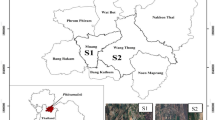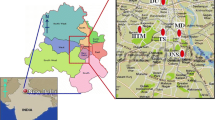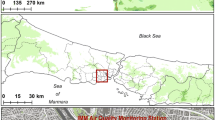Abstract
This study investigates the temporal characteristics of black carbon and its potential emission sources, as well as the fractions of BC in PM2.5 levels in Kaohsiung urban area, which is an industrial city in southern Taiwan. Concentrations of BC and PM2.5 are monitored continuously from March 2006 to February 2010, using an aethalometer and a tapered element oscillating microbalance monitor. Additionally, the presence of organic compounds (or UV enhanced species) in particles at the sampling site is determined using the Delta-C (UVBC-BC) value. According to long-term measurement results, BC and PM2.5 concentrations are 3.33 and 34.0 μg m−3, respectively, in the Kaohsiung urban area. The ratio of BC/PM2.5 is approximately 11 %. Low concentration of BC and PM2.5 in the summer of this study period is mostly likely owing to meteorological conditions that favored dispersion of local air pollutants. Nevertheless, BC concentrations peaked markedly during morning hours (7:00–11:00), likely owing to local traffic congestion. Measurement results suggest that BC is released from local traffic activities and emitted from industrial activities at this sampling site. Additionally, Delta-C values are significantly higher than zero during January–March and November–December periods in this industrial urban area, implying that UV enhanced species can be observed. At this sampling site, these UV enhanced species do not only originate from household activity and solid waste burning but also release from industrial activities. The elevated Delta-C values during nighttime (18:00–6:00) in the autumn and winter seasons are likely related to those UV enhanced species in the atmosphere, which can be condensed on particle surface under low temperature conditions. According to long-term measurement results, significantly positive Delta-C values can be observed under temperatures <20 °C and relative humidity of 60–75 % in this study. Despite the household activity and solid waste burning, the major sources of particles that are bound with UV enhanced species in this sampling site are industrial parks and a coal-fired power plant.










Similar content being viewed by others
References
Arnott WP, Hamasha K, Moosmüller H, Sheridan PJ, Ogren JA (2005) Towards aerosol light-absorption measurements with a 7-wavelenghth aethalometer: evaluation with a photoacoustic instrument and 3-wavelength nephelometer. Aerosol Sci Technol 39:17–29
Begum BA, Hossain A, Nahar N, Markwitz A, Hopke PK (2012) Organic and black carbon in PM2.5 at an urban site at Dhaka, Bangladesh. Aerosol Air Qual Res 12:1062–1072
Bond TC et al (2013) Bounding the role of black carbon in the climate system: a scientific assessment. J Geophys Res: Atmos 118:5380–5552
Boogaard H, Kos GPA, Weijers EP, Janssen NAH, Fischer PH, Zee SC, Hartog JJ, Hoek G (2011) Contrast in air pollution components between major streets and background locations: particulate matter mass, black carbon, elemental composition, nitrogen oxide and ultrafine particle number. Atmos Environ 45:650–658
Carslaw DC, Ropkins K (2012) openair—An R package for air quality data analysis. Environ Modell Softw 27–28:52–61
Chen KS, Ho YT, Lai CH, Tsai YA, Chen SJ (2004) Trends in concentration of ground-level ozone and meteorological conditions during high ozone episodes in the Kao-Ping airshed, Taiwan. J Air Waste Manag Assoc 54:36–48
Cheng YH, Shiu BT, Lin MH, Yan JW (2013) Levels of black carbon and their relationship with particle number levels—observation at an urban roadside in Taipei City. Environ Sci Pollut Res 20:1537–1545
Chou CCK, Lee CT, Cheng MT, Yuan CS, Chen SJ, Wu YL, Hsu WC, Lung SC, Hsu SC, Lin CY, Liu SC (2010) Seasonal variation and spatial distribution of carbonaceous aerosols in Taiwan. Atmos Chem Phys 10:9563–9578
Fruin S, Westerdahl D, Sax T, Sioutas C, Fine PM (2008) Measurements and predictors of on-road ultrafine particles concentrations and associated pollutants in Los Angeles. Atmos Environ 42:207–219
Husain L, Dutkiewicz VA, Khan AJ, Ghauri BM (2007) Characterization of carbonaceous aerosols in urban air. Atmos Environ 41:6872–6883
Invernizzi G, Ruprecht A, Mazza R, Marco CD, Močnik G, Sioutas C, Westerdahl D (2011) Measurement of black carbon concentration as an indicator of air quality benefits of traffic restriction policies within the ecopass zone in Milan, Italy. Atmos Environ 45:3522–3527
Jacobson MZ (2010) Short-term effects of controlling fossil-fuel soot, biofuel soot and gases, and methane on climate, Arctic ice, and air pollution health. J Geophys Res 115:D114209, doi:10.1029/2009JD013795
Jansen KL, Larson TV, Koening JQ, Mar TF, Fields C, Stewart J, Lippmann M (2005) Associations between health effects and particulate matter and black carbon in subjects with respiratory disease. Environ Health Perspect 113:1741–1746
Jeong CH, Hopke PK, Kim E, Lee DW (2004) The comparison between thermal–optical transmittance elemental carbon and Aethalometer black carbon measured at multiple monitoring sites. Atmos Environ 38:5193–5204
Lin CH, Wu YL, Lai CH, Watson JG, Chow JC (2008) Air quality measurements from the southern particulate matter supersite in Taiwan. Aerosol Air Qual Res 8:233–264
Lin JJ, Tai HS (2001) Concentrations and distributions of carbonaceous species in ambient particles in Kaohsiung City, Taiwan. Atmos Environ 35:2627–2636
Pereira SN, Wagner F, Silva AM (2012) Long term black carbon measurements in the southwestern Iberia Peninsula. Atmos Environ 57:63–71
Pérez N, Pey J, Cusack M, Reche C, Querol X, Alastuey A, Viana M (2010) Variability of particle number, black carbon, and PM10, PM2.5, and PM1 levels and speciation: influence of road traffic emissions on urban air quality. Aerosol Sci Technol 44:487–499
Power MC, Weisskopf MG, Alexeeff SE, Coull BA, Spiro A III, Schwartz J (2011) Traffic-related air pollution and cognitive function in a cohort of older men. Environ Health Perspect 119:682–687
Ramanathan V, Carmichael G (2008) Global and regional climate changes due to black carbon. Nat Geosci 1:221–227
Reche C, Querol X, Alastuey A, Viana M, Pey J, Moreno T, Rodríguez S, González Y, Fernández-Camacho R, Sánchez de la Campa AM, De la Rosa J, Dall’Osto M, Prévôt ASH, Hueglin C, Harrison RM, Quincey P (2011) New considerations for PM, Black Carbon and particle number concentration for air quality monitoring across different European cities. Atmos Chem Phys 11:6207–6227
Reddy BSK, Kumar KR, Balakrishnaiah G, Gopal KR, Reddy RR, Reddy LSS, Ahammed YN, Narasimhulu K, Moorthy KK, Babu SS (2012) Potential source regions contributing to seasonal variations of black carbon aerosols over Anantapur in Southeast India. Aerosol Air Qual Res 12:344–358
Rich DQ, Schwartz J, Mittleman MA, Link M, Luttmann-Gibson H, Catalano PJ, Speizer FE, Dockery DW (2005) Association of sort-term ambient air pollution concentrations and ventricular arrhythmias. Am J Epidemiol 161:1123–1132
Sandradewi J, Prévôt ASH, Weingartner E, Schmidhauser R, Gysel M, Baltensperger U (2008) A study of wood burning and traffic aerosols in an Alpine valley using a multi-wavelength Aethalometer. Atmos Environ 42:101–112
Schmid O, Artaxo P, Arnott WP, Chand D, Gatti LV, Frank GP, Hoffer A, Schnaiter M, Andreae MO (2006) Spectral light absorption by ambient aerosols influenced by biomass burning in the Amazon Basin. I: Comparison and field calibration of absorption measurement techniques. Atmos Chem Phys 6:3443–3462
Schulz M, Textor C, Kinne S, Balkanski Y, Bauer S, Berntsen T, Berglen T, Boucher O, Dentener F, Guibert S, Isaksen ISA, Iversen T, Koch D, Kirkevåg A, Liu X, Montanaro V, Myhre G, Penner JE, Pitari G, Reddy S, Seland Ø, Stier P, Takemura T (2006) Radiative forcing by aerosols as derived from the AeroCom present-day and pre-industrial simulations. Atmos Chem Phys 6:5225–5246
Suglia SF, Gryparis A, Schwartz J, Wright RJ (2008) Association between traffic-related black carbon exposure and lung function among urban women. Environ Health Perspect 116:1333–1337
TEPA (2005) Air quality annual report of Taiwan, 2004. Taipei, Taiwan (in Chinese).
Venkatachari P, Zhou L, Hopke PK, Felton D, Rattigan OV, Schwab JJ, Demerjian KL (2006) Spatial and temporal variability of black carbon in New York City, J Geophys Res 111:D10S05, doi:10.1029/2005JD006314.
Viidanoja J, Sillanpää M, Laakia J, Kerminen VM, Hillamo R, Aarnio P, Koskentalo T (2002) Organic and black carbon in PM2.5 and PM10: 1 year of data from an urban site in Helsinki, Finland. Atmos Environ 36:3183–3193
Virkkula A, Mäkelä T, Hillamo R, Yli-Tuomi T, Hirsikko A, Hämeri K, Koponen IK (2007) A simple procedure for correcting loading effects of aethalometer data. J Air Waste Manage Assoc 57:1214–1222
Wang Y, Hopke PK, Rattigan OV, Zhu Y (2011) Characteristic of ambient black carbon and wood burning particles in two urban areas. J Environ Monitor 13:1919–1926
Weingartner E, Saathoff H, Schnaiter M, Streit N, Bitnar B, Baltensperger U (2003) Absorption of light by soot particles: determination of the absorption coefficient by means of aethalometers. J Aerosol Sci 34:1445–1463
Wu C, Larson TV, Wu S, Williamson J, Westberg HH, Liu LJS (2008) Source apportionment of PM2.5 and selected hazardous air pollutants in Seattle. Sci Total Environ 386:42–52
Yuan CS, Lee CG, Liu SH, Chang JC, Yuan C, Yang HY (2006) Correlation of atmospheric visibility with chemical composition of Kaohsiung aerosols. Atmos Res 82:663–679
Zhang Q, Streets DG, Carmichael GR, He KB, Huo H, Kannari A, Klimont Z, Park IS, Reddy S, Fu JS, Chen D, Duan L, Lei Y, Wang LT, Yao ZL (2009) Asian emissions in 2006 for the NASA INTEX-B mission. Atmos Chem Phys 9:5131–5153
Acknowledgments
The authors would like to thank the National Science Council of the Republic of China, Taiwan, for financially supporting this research under Contract No. NSC101-2221-E-131-026. Environmental Protection Administration of the Republic of China, Taiwan, is commended for providing the long-term measurement data.
Author information
Authors and Affiliations
Corresponding author
Additional information
Responsible editor: Constantini Samara
Rights and permissions
About this article
Cite this article
Cheng, YH., Lin, CC., Liu, JJ. et al. Temporal characteristics of black carbon concentrations and its potential emission sources in a southern Taiwan industrial urban area. Environ Sci Pollut Res 21, 3744–3755 (2014). https://doi.org/10.1007/s11356-013-2373-7
Received:
Accepted:
Published:
Issue Date:
DOI: https://doi.org/10.1007/s11356-013-2373-7




